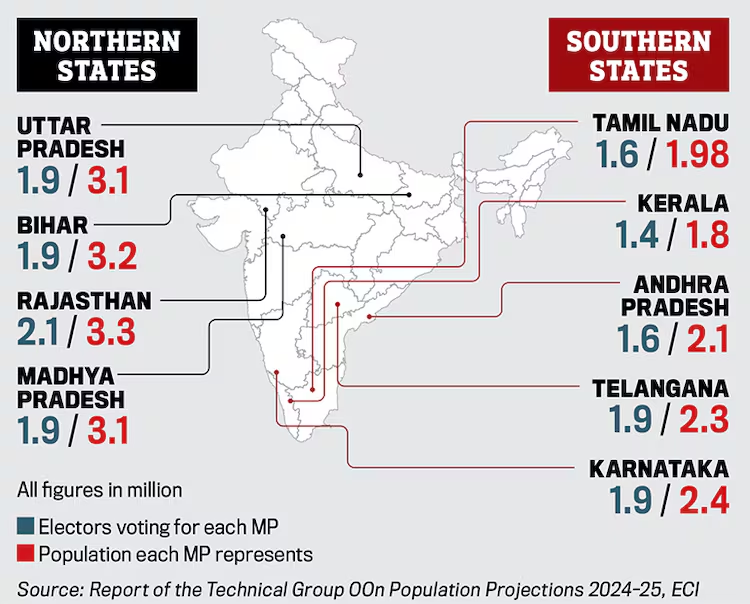Font size:
Print
Delimitation Debate and Electors
Delimiting by electors rather than population
Context: Recent media coverage on India’s upcoming delimitation exercise has sparked concerns that southern States may lose parliamentary representation if the population is used as the primary criterion for allocating Lok Sabha seats.

More on News
- This argument, based on the premise that southern States followed family planning norms more strictly than their northern counterparts, suggests they could face a relative seat disadvantage.
- However, the real question remains largely overlooked: Should population be the sole basis for delimitation, or should the number of electors be prioritised instead?
Why Electors, Not Population, Should Drive Delimitation
Using elector data—the actual number of registered voters—offers a more democratic and realistic measure of representation than using population data. Here’s why:
- Electors ≠ Population: Not all residents are voters.
-
- Many electors live outside their constituencies or fail to register in time.
- Population data from the Census is often skewed by short-term migration, as it counts individuals who stay for six months or even intend to stay, without requiring any proof of residence or voter registration.
- Age Structure Variation: Constituencies with a higher percentage of under-18 residents (who aren’t eligible to vote) may appear large by population but have fewer electors.
- Timeliness and Accuracy: Elector data is updated more regularly than the decennial Census, allowing for more current and precise representation.
- Democratic Integrity: The “one person, one vote, one value” principle aligns more accurately with elector numbers than with population figures.
Understanding Vote Value Disparities
The value of a vote can be understood as inversely proportional to the number of electors in a constituency. Historical data reveals sharp variations:
- Union Territories (UTs), hill States, and the North-East have always had high vote value due to geographical representation norms.
- Southern States started with a higher vote value in 1951, but this advantage reversed during 1961–1999.
- From 2009 onwards, the trend flipped again, giving southern States a relatively higher vote value, with the difference in average elector counts between regions varying from -10.5% to +5%.
- Interestingly, four of the five largest and smallest constituencies by elector size (excluding UTs and hill States) are from southern India.
- For example, a vote in Idukki (Kerala) is 4.5 times more impactful than a vote in Malkajgiri (Telangana), and 2.6 times more than in Bangalore North.
- This indicates an urgent need for internal rationalisation of seats within the southern States.
Disproportionate Representation in the Rajya Sabha
The imbalance is also visible in Rajya Sabha representation:
- Southern States, which account for 22.45% of India’s electors, hold 23.8% of Lok Sabha seats and an even higher 24.4% of Rajya Sabha seats.
- In contrast, the rest of India, with 71.2% of electors, has only 67.4% of Lok Sabha seats and 64.4% of Rajya Sabha seats.
- For instance, Tamil Nadu has only 39 Lok Sabha seats—fewer than Bihar’s 40 and West Bengal’s 42—but has 18 Rajya Sabha seats, more than the 16 seats allotted to either Bihar or West Bengal.
A Data-Driven Alternative: Delimitation Based on Electors
- If the Lok Sabha is expanded to 800 seats and the current seat count for smaller States and UTs is preserved, a more equitable distribution emerges:
- Rajasthan could gain 76% more seats
- Karnataka may gain 60.7%
- Telangana could see a 58.8% increase
- This approach ensures fair representation based on active political participation, not outdated or misleading population figures.
Debunking the Southern States vs. North Narrative
The claim that southern States are penalised for better population control is simplistic and flawed. Here’s why:
- Constituency allocation has never relied solely on population.
-
-
- Other factors like geography, diversity, and minimum representation have always influenced seat distribution.
-
- Linking representation to fertility rates sets a dangerous precedent.
-
- By this logic, should communities with lower fertility—like Jains or upper castes—demand more political power?
- Conversely, should Muslims or Scheduled Tribes, who have higher fertility rates, be penalised?
- Census methodology fails to account for internal migration, further distorting population-based seat allocation.
- Elector data, updated every few years, presents a clearer and fairer picture of voter strength.


